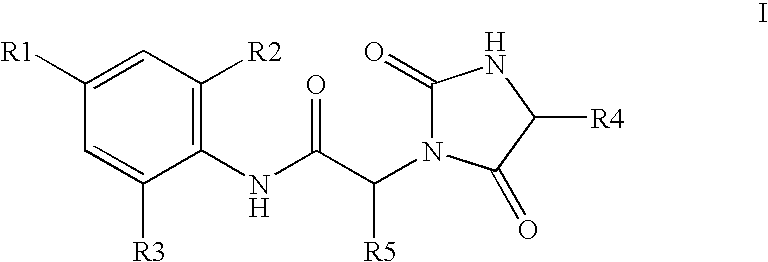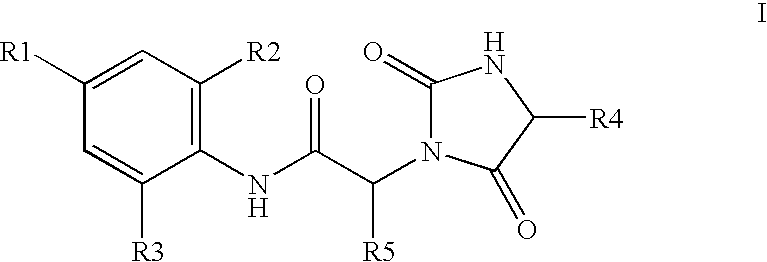Substituted hydantoins
a technology of hydantoin and derivatives, applied in the field of hydantoin derivatives, can solve the problems of mitogenic signals within the cells of purified mitogens
- Summary
- Abstract
- Description
- Claims
- Application Information
AI Technical Summary
Benefits of technology
Problems solved by technology
Method used
Image
Examples
example i
(2S,3S)—N-(4-Bromo-phenyl)-2-[(R)-4-(4-methoxy-phenyl)-2,5-dioxo-imidazolidin-1-yl]-3-phenyl-butyramide
[0079]
[0080]Step 1: To a solution of (2S,3S)-2-tert-butoxycarbonylamino-3-phenyl-butyric acid (838 mg, 3.0 mmol) in dichloromethane (10 mL) at −35° C. was added dry pyridine (255 μL, 3.15 mmol) and cyanuric fluoride (375 μL, 4.5 mmol) under an atmosphere of dry argon. The mixture was stirred for 1.5 hours while maintaining the temperature between −35 and −25° C. A small amount of ice was added to the reaction mixture and the mixture stirred vigorously for 15 minutes. The organic layer was decanted away from the aqueous solution and the aqueous layer extracted with dichloromethane (2×10 mL). The combined organic layers were washed with ice cold water (15 mL), dried over sodium sulfate, filtered and concentrated in vacuo to give (1-fluorocarbonyl-2-phenyl-propyl)-carbamic acid tert-butyl ester which was used in the subsequent step without further purification.
[0081]Step 2: To a solut...
example 2
(2S,3S)—N-(4-Bromo-2-fluoro-phenyl)-2-{(R)-4-[4-((R)-2,3-dihydroxy-propoxy)-phenyl]-2,5-dioxo-imidazolidin-1-yl}-3-phenyl-butyramide
[0091]
[0092]Prepared by the same method as described in example 1 except that (i) 4-bromo-2-fluoroaniline was used in place of 4-bromoaniline in step 2, and (ii) (R)-tert-butoxycarbonylamino-[4-((S)-2,2-dimethyl-[1,3]dioxolan-4-ylmethoxy)-phenyl]-acetic acid was used in place of (R)-tert-butyloxycarbonylamino-4-methoxyphenylglycine in step 4. (R)-tert-Butoxycarbonylamino-[4-((S)-2,2-dimethyl-[1,3]dioxolan-4-ylmethoxy)-phenyl]-acetic acid was prepared and used as described in example 114.
[0093]HRMS: Obs Mass (M+H+), 600.1137. Calcd. Mass, 600.1140 for C28H28BrFN3O6−.
example 3
(2S,3S)—N-(4-Bromo-2-chloro-phenyl)-2-{(R)-4-[4-(2-hydroxy-ethoxy)-phenyl]-2,5-dioxo-imidazolidin-1-yl}-3-phenyl-butyramide
[0094]
[0095]Step 1: 4-Bromo-2-chloro-aniline (325 mg, 1.58 mmol) and (S,S)-2-tert-butoxycarbonylamino-3-phenyl-butyric acid (440 mg, 1.58 mmol) in pyridine (5 mL) were cooled to −30° C. Phosporus oxychloride (0.158 mL, 1.7 mmol) was added and stirred at −20° C. for 2 hours. The mixture was poured into ice water and extracted with ethyl acetate (3×). The combined organic extracts were washed with water, brine, dried over sodium sulfate and concentrated in vacuo. The residue was dissolved in dichloromethane (5 mL) at 0° C. and trifluoroacetic acid (3 mol) added. Stirring was continued for 2 hours at 0° C. The mixture was evaporated and the residue dissolved in ether. The ether solution was basified with saturated aqueous sodium bicarbonate and extracted with ether. The organic extracts were washed with brine, dried over sodium sulfate and evaporated to give (2S,3S...
PUM
 Login to View More
Login to View More Abstract
Description
Claims
Application Information
 Login to View More
Login to View More - R&D
- Intellectual Property
- Life Sciences
- Materials
- Tech Scout
- Unparalleled Data Quality
- Higher Quality Content
- 60% Fewer Hallucinations
Browse by: Latest US Patents, China's latest patents, Technical Efficacy Thesaurus, Application Domain, Technology Topic, Popular Technical Reports.
© 2025 PatSnap. All rights reserved.Legal|Privacy policy|Modern Slavery Act Transparency Statement|Sitemap|About US| Contact US: help@patsnap.com



